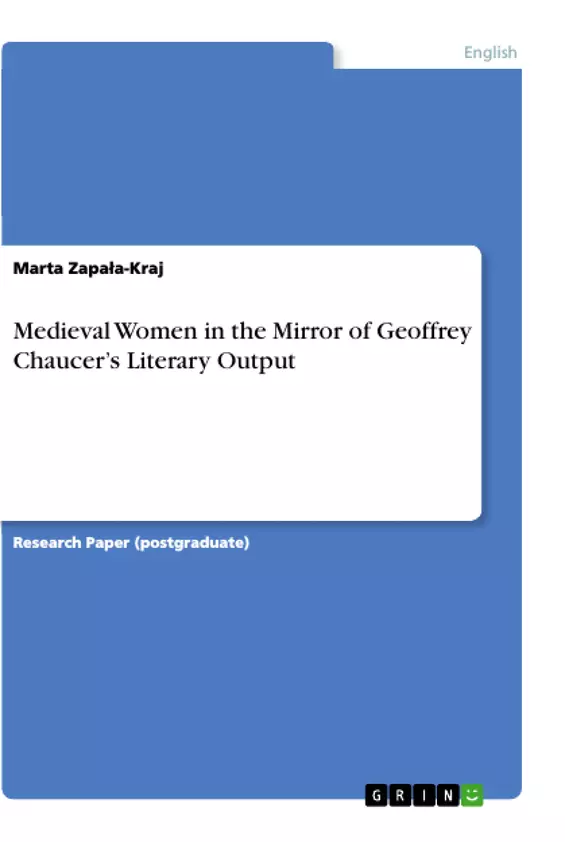What can we say about Chaucer’s life with certainty? If we were to be honest – nothing can be said about either his private life or, for example, the exact date of his birth. He, himself – the one who led the English literature to the European peaks, mentions in 1386 that he might be "forty and something".
Chaucer’s life was quite well recorder in numerous official documents. In the further part of my discourse I shall explain why it was so. Geoffrey Chaucer – using the pathetic description - one of the Founding Fathers of English literature, had glamorous and satisfying from the mercantile point of view life. His career allowed him to travel extensively and to see and experience much more than the average human-being of the Middle Ages could imagine.
The rare periods in his life when he was short of money revealed the self-made man, able to find himself a job that would provide him satisfying profit. What else than a broad mind and brilliant career could satisfy a medieval man? Chaucer proved to be a man far ahead his times, someone whom we could call the Renaissance Man. Being exposed to art and literature, the achievements of his age, he decided to take part in creating it, not only being a passive observer.
And so not only did he translate fragments of Italian and French literature to make them broadly known in his home country but also he wrote his own outstanding works. Most of them probably imitations or borrowings from French or Italian texts. However, Chaucer’s unquestionable skill to portray and mock the society of the Medieval times will remain immortal in the superb Canterbury Tales.
Inhaltsverzeichnis (Table of Contents)
- Chapter One. Chaucer - Poet - Ambassador
- Chaucer's Times
- Chaucer's Biography
- Chapter Two. Women of Middle Ages
- Women's Education
- Womanhood Allure
- Love, the Twelfth Century's Invention
- The Working Women
- Chapter Three. The Development of Medieval English Literature
- The Impact of French
- The Shift from Handwriting to Printing and its Results
- Development of the New Styles: Epic and Romance
- Chapter Four. Medieval Women in the Mirror of Chaucer's Writing
- The Making of The Canterbury Tales
- The Women of Canterbury Tales
- How Happy is Life of the Widow - the Wife of Bath's Tale
- Where Allegory Turns into Torment – the Clerk's Tale
- From January to May - the Merchant's Tale
- The Meaning of the Canterbury Tales in the Aspect of Womanhood
Zielsetzung und Themenschwerpunkte (Objectives and Key Themes)
This book aims to explore the representation of medieval women in Chaucer's literary output. It examines the historical context of Chaucer's life and times, highlighting the social and political influences on his work. Key themes explored include:- The role of women in medieval society
- The portrayal of women in Chaucer's writing
- The influence of the Hundred Years War and other historical events on Chaucer's work
- The development of medieval English literature
- The significance of The Canterbury Tales in understanding the representation of women in the Middle Ages
Zusammenfassung der Kapitel (Chapter Summaries)
Chapter One: Chaucer - Poet - Ambassador
This chapter explores the life and times of Geoffrey Chaucer, emphasizing the influence of his personal experiences and the historical context on his literary work. It delves into the complexities of Chaucer's life, including his career as a poet, ambassador, and civil servant, highlighting his exposure to various aspects of medieval society.Chapter Two: Women of the Middle Ages
This chapter investigates the social and cultural realities of women during the Middle Ages, focusing on their education, roles in society, and perceptions of love and womanhood. It explores the societal limitations and opportunities presented to women of this era.Chapter Three: The Development of Medieval English Literature
This chapter traces the evolution of medieval English literature, emphasizing the impact of French influence, the transition from handwritten manuscripts to printed texts, and the rise of new literary styles such as epic poetry and romance. It examines the literary landscape that shaped Chaucer's work.Chapter Four: Medieval Women in the Mirror of Chaucer's Writing
This chapter analyzes the representation of women in Chaucer's Canterbury Tales, focusing on the portrayals of female characters and their roles within the narrative framework. It examines specific tales such as the Wife of Bath's Tale, the Clerk's Tale, and the Merchant's Tale, highlighting the themes of love, marriage, and societal expectations.Schlüsselwörter (Keywords)
The book focuses on the key themes of medieval women, Chaucer's literary output, The Canterbury Tales, historical context, social and political influences, representation, women in medieval society, love, marriage, and societal expectations.- Quote paper
- Marta Zapała-Kraj (Author), 2021, Medieval Women in the Mirror of Geoffrey Chaucer’s Literary Output, Munich, GRIN Verlag, https://www.grin.com/document/1140370



